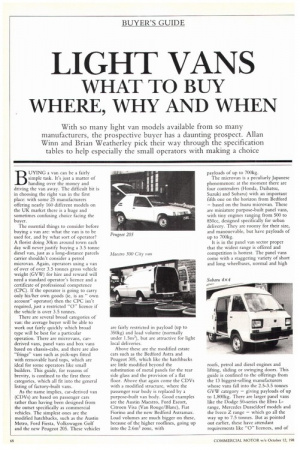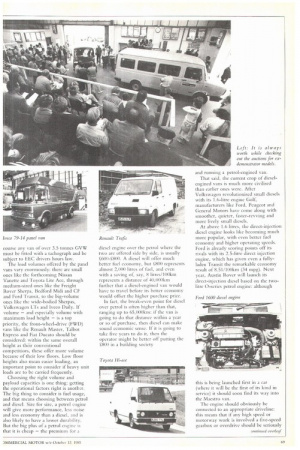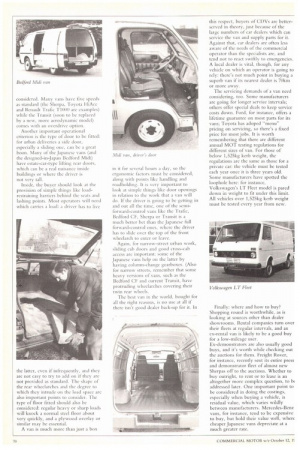LIGHT VANS
Page 70

Page 71

Page 72

If you've noticed an error in this article please click here to report it so we can fix it.
WHAT TO BUY WHERE, WHY AND WHEN
With so many light van models available from so many manufacturers, the prospective buyer has a daunting prospect. Allan Winn and Brian Weatherley pick their way through the specification tables to help especially the small operators with making a choice
BUYING a van can be a fairly simple task. It's just a matter of handing over the money and driving the van away. The difficult bit is in choosing the right van in the first place: with some 25 manufacturers offering nearly 160 different models on the UK market there is a huge and sometimes confusing choice facing the buyer.
The essential things to consider before buying a van are: what the van is to be used for, and by what sort of operator? A florist doing 30km around town each day will never justify buying a 3.5 tonne diesel van, just as a long-distance parcels carrier shouldn't consider a petrol microvan. Again, operators using a van of over of over 3.5 tonnes gross vehicle weight (GVW) for hire and reward will need a standard operator's licence and a certificate of professional competence (CPC). If the operator is going to carry only his/her own goods (ie, is an "own account" operator) then the CPC isn't required, just a restricted "0" licence if the vehicle is over 3.5 tonnes.
There are several broad categories of van: the average buyer will be able to work out fairly quickly which broad type will be best for a particular operation. There are microvans, carderived vans, panel vans and box vans based on chassis-cabs, and there are also "fringe" vans such as pick-ups fitted with removable hard tops, which are ideal for some operators like small builders. This guide, for reasons of brevity, is confined to the first three categories, which all fit into the general listing of factory-built vans.
As the name implies, car-derived van (CDVs) are based on passenger cars rather than having been designed from the outset specifically as commercial vehicles. The simplest ones are the modified hatchbacks, such as the Austin Metro, Ford Fiesta, Volkswagen Golf and the new Peugeot 205. These vehicles are fairly restricted in payload (up to 350kg) and load volume (normally under 1.5m3), but are attractive for light local deliveries.
Above these are the modified estate cars such as the Bedford Astra and Peugeot 305, which like the hatchbacks are little modified beyond the substitution of metal panels for the rear side glass and the provision of a flat floor. Above that again come the CDVs with a modified structure, where the passenger rear body is replaced by a purpose-built van body. Good examples are the Austin Maestro, Ford Escort, Citroen Visa (Van Rouge/Blanc), Fiat Fiorino and the new Bedford Astramax. Load volumes are much bigger on these, because of the higher rooflines, going up into the 2,6m3 zone, with
payloads of up to 700kg.
The microvan is a peculiarly Japanese phenomenon: at the moment there are four contenders (Honda, Daihatsu, Suzuki and Subaru) with an important fifth one on the horizon from Bedford — based on the lsuzu microvan. These are miniature purpose-built panel vans, with tiny engines ranging from 500 to 850cc, designed specifically for urban delivery. They are roomy for their size, and manouevable, but have payloads of up to 700kg.
It is in the panel van sector proper that the widest range is offered and competition is hottest. The panel vans come with a staggering variety of short and long wheelbases, normal and high
roofs, petrol and diesel engines and lifting, sliding or swinging doors. This guide is confined to the offerings from the 13 biggest-selling manufacturers whose vans fall into the 2.5-3.5 tonnes GVW category — giving payloads of up to 1,800kg. There are larger panel vans like the Dodge 50-series the Ebro Lrange, Mercedes Dusseldorf models and the Iveco Z range — which go all the way up to 7.5 tonnes. But as pointed out earlier, these have attendant requirements like "0" licences, and of
course any van of over 3.5 tonnes GVW must be fitted with a tachograph and be subject to EEC drivers hours law.
The load volumes offered by the panel vans vary enormously: there arc small ones like the forthcoming Nissan Vanette and Toyota Lite Ace, through medium-sized ones like the Freight Rover Sherpa, Bedford Midi and CF and Ford Transit, to the big-volume ones like the wide-bodied Sherpas, Volkswagen LTs and lveco Daily. If volume — and especially volume with maximum load height — is a top priority, the front-wheel-drive (FWD) vans like the Renault Master, Talbot Express and Fiat Ducat° should be considered: within the same overall height as their conventional competitiors, these offer more volume because of their low floors. Low floor heights also mean easier loading, an important point to consider if heavy unit loads are to be carried frequently.
Choosing the right volume and payload capacities is one thing: getting the operational factors right is another. The big thing to consider is fuel usage, and that means choosing between petrol and diesel. Size for size, a petrol engine will give more performance, less noise and less economy than a diesel, and is also likely to have a lower durability. But the big plus of a petrol engine is that it is cheap — the premium for a diesel engine over the petrol where the two are offered side by side, is usually £60(14800. A diesel will offer much better fuel economy, but .i11.I{X) represents almost 2,000 litres of fuel, and even with a saving of, say, 8 litres/100km represents a distance of 40,000km further that a diesel-engined van would have to travel before its better economy would offset the higher purchase price.
In fact, the break-even point for diesel over petrol is often higher than that, ranging up to 65,000km: if the van is going to do that distance within a year or so of purchase, then diesel can make sound economic sense. If it is going to take five years to do it, then the operator might be better off putting the ti.:800 in a building society and running a petrol-engined van. That said, the current crop of dieselengined vans is much more civilised than earlier ones were. After Volkswagen revolutionised small diesels with its 1.6-litre engine Golf, manufacturers like Ford, Peugeot and General Motors have come along with smoother, quieter, faster-revving and more lively small diesels.
At above 1.6 litres, the direct-injection diesel engine looks like becoming much more popular, with even better fuel economy and higher operating speeds. Ford is already scoring points off its rivals with its 2.5-litre direct injection engine, which has given even a fullyladen Transit the remarkable economy result of 8.51/100km (34 mpg). Next year, Austin Rover will launch its direct-injection diesel based on the twolitre 0-series petrol engine: although this is being launched first in a car (where it will be the first of its kind in service) it should soon find its way into the Maestro van.
The engine should obviously be connected to an appropriate driveline: this means that if any high speed or motorway work is involved a five-speed gearbox or overdrive should be seriously
considered. Many vans have five speeds as standard (the Sherpa, Toyota HiAce and Renault Trafic T1000 are examples) while the Transit (soon to be replaced by a new. more aerodynamic model) comes with an overdrive option.
Another important operational criterion is the type of door to be fitted: for urban deliveries a side door, especially a sliding one, can be a great boon. Many of the Japanese vans (and the designed-in-Japan Bedford Midi) have estate-car-type lifting rear doors, which can be a real nuisance inside buildings or where the driver is not very tall.
Inside, the buyer should look at the provision of simple things like loadrestraining barriers behind the seats and lashing points. Most operators will need which carries a load: a driver has to live the latter, even if infrequently, and they are not easy to try to add on if they are not provided as standard. The shape of the rear wheelarches and the degree to which they intrude on the load space are also important points to consider. The type of floor fitted should also be considered: regular heavy or sharp loads will knock a normal steel floor about very quickly, and a plywood overlay or similar may be essential.
A van is much more than just a box in it for several hours a day, so the ergonomic factors must be considered, along with points like handling and roadholding. It is very important to look at simple things like door openings in relation to the work that a van will do. If the driver is going to be getting in and out all the time, one of the semiforward-control vans like the Tragic, Bedford CF, Sherpa or Transit is a much better bet than the Japanese full forward-control ones, where the driver has to slide over the top of the front wheelarch to enter or leave.
Again, for narrow-street urban work, sliding cab doors and good cross-cab access are important: some of the Japanese vans help on the latter by having column-change gearboxes. (Also for narrow streets, remember that sonic heavy versions of vans, such as the Bedford CI: and current Transit, have protruding wheelarches covering their twin rear wheels.
The best van in the world, bought for all the right reasons, is no use at all if there isn't good dealer back-up for it. In
this respect, buyers of Cl) Vs are betterserved in theory, just because of the large numbers of car dealers which can service the van and supply parts for it. Against that, car dealers are often less aware of the needs of the commercial operator than the specialists are, and tend not to react swiftly to emergencies. A local dealer is vital, though, for any vehicle on which an operator is going to rely: there's not much point in buying a superb van if its nearest dealer is 70km or more away.
The servicing demands of a van need considering, too. Some manufacturers are going for longer service intervals; others offer special deals to keep service costs down. Ford, for instance, offers a lifetime guarantee on most parts for its vans; Toyota has adoped "menu" pricing on servicing, so there's a fixed price for most jobs. It is worth remembering that there are different annual MOT testing regulations for different sizes of van. For those of below 1,525kg kerb weight, the regulations are the same as those for a private car: the vehicle must be tested each year once it is three years old. Some manufacturers have spotted the loophole here: for instance, Volkswagen's LT Fleet model is pared down in weight to fit under this limit. All vehicles over 1,525kg kerb weight must be tested every year from new.
Finally: where and how to buy? Shopping round is worthwhile, as is looking at sources other than dealer showrooms. Rental companies turn over their fleets at regular intervals, and an ex-rental van is likely to be a good buy for a low-mileage user. Ex-demonstrators are also usually good buys, and it's worth while checking out the auctions for them. Freight Rover, for instance, recently sent its entire press and demonstrator fleet of almost new Sherpas off to the auctions. Whether to buy outright, to rent or to lease is an altogether more complex question, to IN addressed later. One important point to be considered in doing the costings, especially when buying a vehicle, is residual value, which varies wildly between manufacturers. Mercedes-Benz vans, for instance, tend to be expensive to buy, but hold their value well, where cheaper Japanese vans depreciate at a much greater rare.












































































































